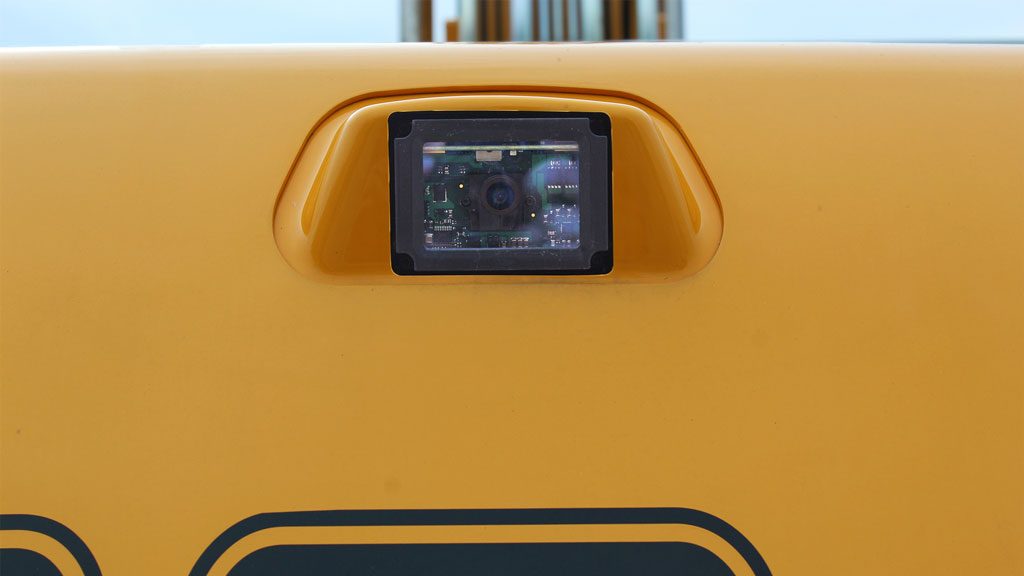Mobile construction equipment has put a lot of power at an operator’s fingertips, but they are also big machines and the view from the cab isn’t always the best to get work done.
“According to a safety bulletin from Ontario’s Ministry of Labour on operating construction equipment in reverse, if you have a blind spot and no safety spotter, you cannot back up at all,” states Steve Widomski, director at SafetyView Systems and president of All Ontario Construction Equipment Inc.
More stringent safety standards, combined with rugged cameras and instant video transmission to a high-quality, factory-installed monitor inside the cab of a machine, are leading to the adoption of greater camera use on construction equipment.
“Mobile machines working near workers greatly benefit from cameras, because it seriously decreases the chance of a worker getting struck by a machine,” says Marc Lefebvre of RMT Equipment, a dealer representative for Orlaco, which is a manufacturer of camera and radar solutions for the construction industry. “Cameras on heavy equipment are becoming more popular because new legislation dictates that machines of a certain size must be equipped with cameras. New equipment such as excavators, wheel loaders and dozers come factory equipped with it. Customers are seeing cameras on their new machines and they want them for the older machines in their fleet, so they look for aftermarket solutions.”
360-degree visibility
Hyundai Construction Equipment Americas has introduced on its HX series excavators and HL900 series wheel loaders optional All Around View Monitoring (AAVM), which uses four cameras to provide 360 degrees of visibility.
To achieve this, a camera is installed on the front of the cab, on each side of the machine and on the rear. From inside the cab the operator can view on the machine’s colour monitor a 360-degree picture around the machine, a top-down view, side views and several other views for a total of 10 different camera view options.
High-tech, rugged environment
Not any camera can be fastened to a construction machine.
“Automotive cameras don’t stand up to Canadian construction environments,” says Widomski. “SafetyView Systems cameras are heated, waterproof, shockproof and power washed in minus 45-degree solution, so they stay clean.
“In Canada, we can get snow and slush from November to April, and not a lot of equipment is designed to work in this environment. I developed the SafetyView system specifically for this environment.”
Orlaco cameras are sealed and podded with liquid that removes all the air from inside. This means you can’t get dust or other particulates in it, states the company.
“Everyone has backup cameras. Orlaco sells vision solutions,” says Lefebvre. “With Orlaco cameras, you can have up to seven view options. The camera on the rear of a wheel loader is 118 degrees. We offer cameras with 20-degree angles. Sometimes seeing too much is not safe.”
In the field
Cameras aren’t being installed just for safety reasons, they are being installed for efficiency and productivity reasons too.
“One of our customers has one on the stick (the second part of the ‘arm’) of an excavator,” says Lefebvre. “The excavator is equipped with a grapple. When truck loading or reaching behind a wall, the operator loses visibility to the grapple and work site area. Sometimes the material being handled by the grapple obstructs the operator’s view. Putting a camera on the stick allows the operator to have a better view of the attachment and work site area, thereby increasing efficiency and safety.”
Another one of RMT’s customers, a quarry, has equipped both their wheel loader and crusher each with a camera. The camera on the wheel loader is to aid in reversing. The camera on the crusher shows what is happening in the crushing chamber. When the wheel loader, which is tasked with feeding rocks into the crusher, comes within a certain distance of the crusher, the monitor in the wheel loader cab automatically picks up the feed from the crusher. This allows the operator to see how much rock is in the crushing chamber so they can better decide how fast to feed the crusher.
“One of our customers counts the City of Toronto, the City of Mississauga and the City of Brampton among their clients. To bid on many municipal projects, you have to be COR certified,” says Widomski. “You have to abide by the safety laws 100 per cent; you can’t even have one infraction. They want to put the cameras on everything, even on backhoes, which don’t have a blind spot, just to be compliant.”
Video plus radar
Having video in the cab is a passive means of promoting safety in that it relies on the operator having to look at the monitor. Sometimes, a video can even be a distraction.
For these and other reasons, radar, which uses an audible alarm, is sometimes preferred, says Lefebvre.
“The market is now adopting cameras plus radar,” says Lefebvre. “We offer the radar eye and have installed hundreds of them in the last few years. The radar technology detects objects up to 30 metres from the rear of the machine. Radar plus camera is the ultimate protection.”
Hyundai’s AAVM also includes the company’s IMOD (Intelligent Moving Object Detection) system that uses radar to detect when objects or people come within range and then warns the operator of the presence.
“Object detection uses either sonar or radar. The object detection on newer cars is probably sonar. Our object detection uses radar at 24 gigahertz, so it is microwave range. The image gets displayed on the monitor inside the cab,” says Widomski. “We sell these units out west. Enbridge demands machines be equipped with object detection, as well as a rear camera and a side camera in order for the safest working environment when working alongside mobile equipment.”







Recent Comments